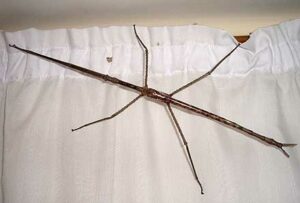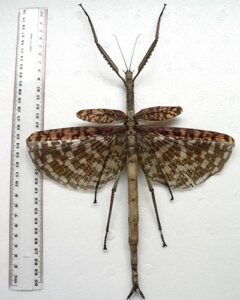Acrophylla Titan, also called the Titan stick insect, is an amazing insect belonging to the group of animals called Arthropods and the order of insects known as Phasmatodea.
Acrophylla Titan, also known as the Giant Stick Insect, is a fascinating bug that belongs to the group called Phasmatodea. These insects are cool because they look a lot like sticks or twigs.
In this article, we will delve into the physical characteristics, habitat, feeding habits, reproductive behaviour, and conservation status of Acrophylla Titan.
Taxonomy and Classification of Acrophylla Titan – Let’s take a look!
Acrophylla Titan is like a giant in the insect world, and scientists have a special way of talking about where it belongs. They say it’s part of the Phasmatidae family and the Acrophylla group, which is a big family of stick insects.
The name “Titan” is just a cool way of saying these insects are huge and impressive. Imagine them being the giants among stick insects! So, Acrophylla Titan is part of this big family of bugs that look like sticks, and they stand out because they’re not just any stick insects – they’re some of the biggest ones around.
People who like insects and nature find these Titan insects fascinating because of their big size and interesting features. In the world of stick insects, Acrophylla Titan is like a superhero, making the insect family even more diverse and exciting.
Habitat And Distribution Of Acrophylla Titan – Don’t Miss Out!
- Natural Habitat of Acrophylla Titan:
Acrophylla Titan is native to the rainforests and tropical regions of Australia, specifically in Queensland and New South Wales. These insects thrive in dense vegetation and tree canopies, where they can easily camouflage themselves among the foliage and avoid detection.
- Geographic Distribution:
Although their natural habitat is limited to Australia, Acrophylla Titan has managed to capture the attention of insect enthusiasts worldwide.
Due to their captivating appearance, individuals have been introduced into captivity as pets or for educational purposes, giving people from different regions the opportunity to appreciate their unique beauty.
Behavior And Adaptations Of Acrophylla Titan – Explore New Horizons!

1. Feeding Behavior and Diet:
Acrophylla Titan is primarily herbivorous, relying on a diet of leaves, flowers, and other plant matter. Their strong mandibles allow them to chew through various plant structures, extracting the necessary nutrients.
These insects have a slow feeding rhythm, meticulously consume their food, and often maintain a motionless demeanour to avoid attracting unwanted attention.
2. Defensive Mechanisms and Adaptations:
When faced with predators or threats, Acrophylla Titan showcases an array of defence mechanisms. Their primary strategy is to remain motionless and rely on their outstanding camouflage skills to blend seamlessly with their surroundings.
If provoked, they may sway or use their spiny legs to mimic the appearance of a dangerous creature, discouraging any potential attackers.
3. Mating Behavior and Courtship Rituals:
Mating in Acrophylla Titan begins with courtship rituals performed by males to attract females. These rituals involve various movements, such as swaying, shaking, or tapping the female with their antennae.
Once a female selects a suitable mate, copulation occurs, and the female subsequently lays her eggs. The offspring, known as nymphs, resemble miniature versions of adults and undergo several moulting stages before reaching maturity.
Threats And Conservation Efforts For Acrophylla Titan – Learn Something Amazing!

Natural Predators and Threats:
Just because Acrophylla Titan is a giant insect doesn’t mean they’re invincible. They have their fair share of natural predators, like birds and reptiles, that would love to make a meal out of them. It’s a tough world out there, even for titanic critters.
They must constantly be on their guard, using their impressive camouflage skills to blend into their surroundings.
Human Impact and Habitat Loss:
Unfortunately, humans also pose a threat to the Acrophylla Titan population. As we continue to encroach upon their natural habitats, these magnificent creatures face habitat loss and fragmentation.
Deforestation and urbanization are forcing them to adapt or perish. It’s a wake-up call for us to reassess our impact on the environment and find ways to coexist peacefully.
Conservation Measures and Initiatives:
Thankfully, bright minds are working to protect these incredible insects. Conservation efforts focus on preserving their natural habitats, promoting sustainable land use, and raising awareness about the importance of biodiversity.
By safeguarding the environments in which Acrophylla Titan thrives, we can give them a fighting chance for survival. After all, we’re all in this bug-infested world together!
Frequently Asked Questions:
1. What is the average size of Acrophylla Titan?
Acrophylla Titan is one of the largest stick insect species, with females reaching an average length of 20 to 25 centimetres (8 to 10 inches), while males are slightly smaller, measuring around 15 to 20 centimetres (6 to 8 inches) in length.
2. How does Acrophylla Titan camouflage itself?
Acrophylla Titan employs remarkable camouflage techniques to blend seamlessly with its environment. Its body structure and colouration closely resemble dry leaves or twigs, allowing it to hide from predators by mimicking its surroundings.
3. Where can Acrophylla Titan be found?
Acrophylla Titan is native to Australia and can be found in various regions across the continent, including Queensland and New South Wales. It typically inhabits forests, rainforests, and other vegetation-rich areas.
4. Are Acrophylla Titan’s populations at risk?
Yes, like many other insect species, Acrophylla Titan faces threats to its populations. Loss of habitat due to deforestation, urbanization, and agricultural activities pose significant risks to their survival.
To sum up:
Acrophylla Titan shows us how amazing and diverse nature can be. This insect is extraordinary because of its special features and behaviours. But, there’s a problem – its homes are getting lost, and there are other dangers too.





